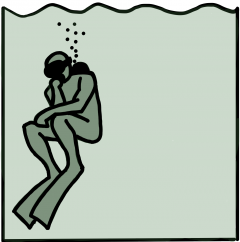I would like to hear your opinion about isobaric counter diffusion (ICD) and the criteria you apply to decide if a gas switch should be considered dangerous.
But first a bit of background to make sure we are all on the same page: ICD is the phenomenon that occurs when you switch from a mix with a lot of helium to a mix that contains less helium but more nitrogen. Then it can happen (depending on the tissue loading) that some tissue is off-gassing He but on-gassing N2, i.e. that the two inert gases move in opposite directions. And historically this is considered bad for your deco.
As the He atoms are much small than the N2 molecules the former diffuses faster than the latter so, in typical situations, in total the off-gassing should happen on a shorter timescale than the on-gassing and thus the net effect will be that the tissues inert gas loading goes down. Anyway, this effect should be covered by the usual diffusion based deco algorithm (as this is exactly what it simulates) and no additional care would need to be taken as long as the diver stays within the boundary of the deco algorithm.
There is, however, an argument due to Steve Burton that suggests to take the solubility of the gases (in typical tissue) into account to compute the absolute amount of inert gases in the body. And since that is about 5 times higher for N2 than for He, he argues that in order to have a net unloading of the absolute amount of gas one has to limit the change in N2 percentage in the breathing gas by 1/5 of the change in He percentage in the breathing gas. And at least one technical diving school of teaching seems to have adopted this criterium.
We are currently discussing if we implement this check into Subsurface and warn the user if a gas switch violates this “rule of fifth”. I am not sure though if I buy into this line of thought. After all, everything we do in deco planning is based on partial pressures, we never consider the absolute amount of gas. It is the partial pressure that plays the role of the fugacity determining if a particle moves across the diffusion boarder (in or out of the tissue say) and the rate is proportional to the differences (this is the mantra of diffusion based decompression models). So the solubility and with it the total amount of gas should play no direct role. I wonder if this rule of fifth (as is seems it comes out of a theoretical consideration with questionable initial assumptions) has received any empirical evaluation. Note that for example it forbids to change from Tx18/45 directly to EAN50 (as He goes down by 45% of which a fifth is 9% while the N2 fraction increases by 13 percentage points, more than 9%) even though I understand this is rather commonly done.
There is another ICD theory investigated by Doolette and Mitchell that focusses on inner ear DCS. They argue that in the inner ear the common diffusion model assumptions are violated since there is a relatively large amount of inner ear liquid that is not in direct (diffusive) contact with them ambient pressure (blood in practice) but only indirectly via inner ear tissue. So all off-gassing of the liquid goes first into the tissue. So what happens in an ICD caused inner ear DCS accident is that while that tissue is already on-gassing N2 from the environment (=blood) it is still receiving the He that comes out of the liquid and therefore experiences an over all uptake in inert gas which eventually causes DCS.
But i have not seen any hard “you should avoid doing the following” criterion that is derived from this line of thought beyond a general “shouldn’t really be a problem when using a CCR and otherwise be careful and always maximise the O2 fraction within the boundaries set by MOD”.
So, for the deeper trimix divers here: How do you decide which gas switches are ok and do you want your dive planning software to warn you about those.
PS: A last warning: It makes no sense to think about ICD in a way like “stuff moves in different directions, so the in-moving particles clog the out-going ones” as this little thought experiment shows: There are two stable nitrogen isotopes N-14 and N-15 (the former much more common in nature) that are chemically not distinguishable (only for example in a mass spectrometer). Image you are breathing a nitro mix with only N-14. Then you switch to the same mix but with all the N-14 replaced by N-15. Then there will be a counter diffusion of N-14 vs N-15. But of course, since both are chemically equivalent there are absolutely zero physiological consequences even, so the argument that the in-moving N-15 clogs up the out-moving N-14 cannot hold (and so it cannot hold in the case above).

